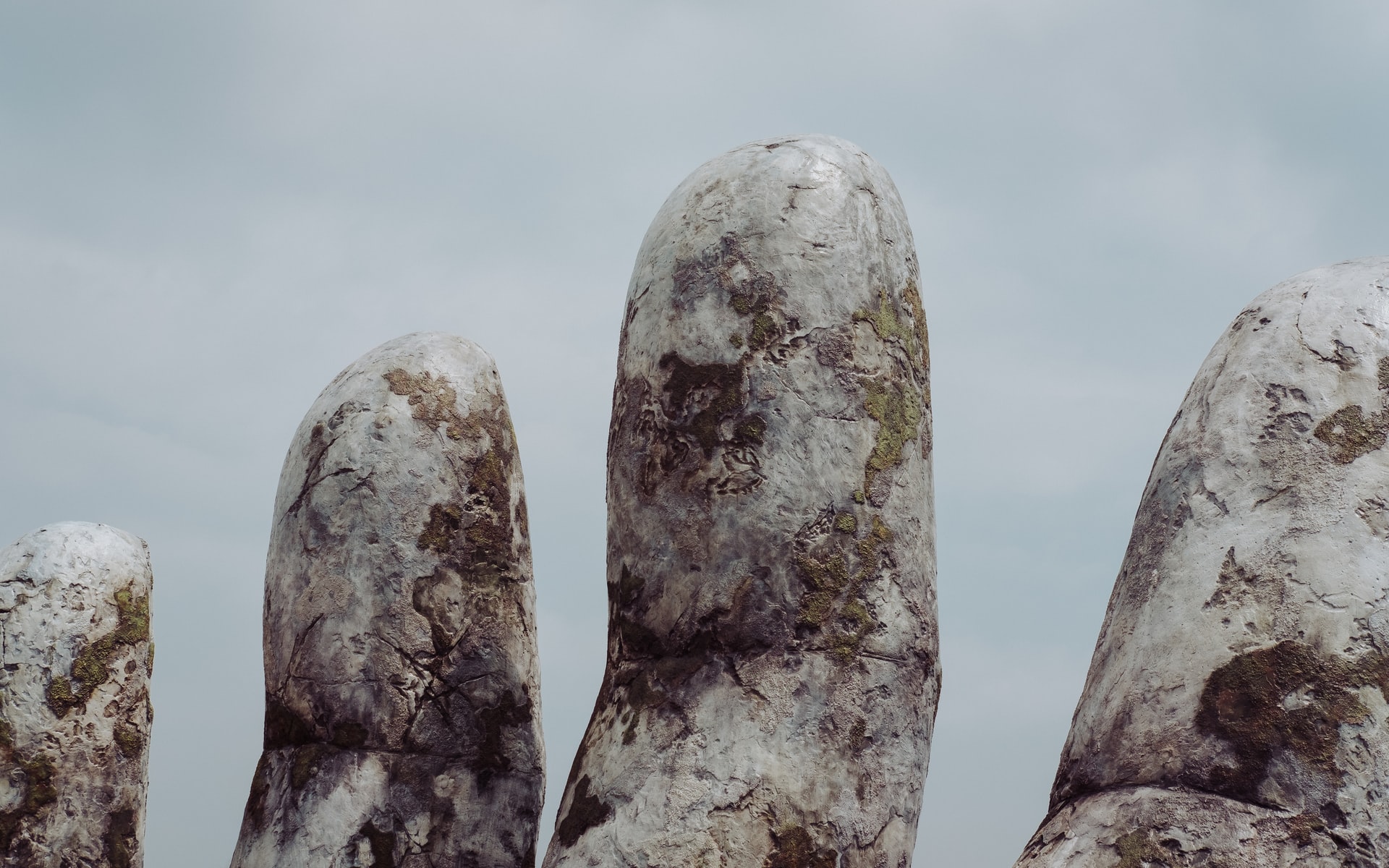
by DGR News Service | May 9, 2021 | Biodiversity & Habitat Destruction, Colonialism & Conquest, Education, Mining & Drilling, Strategy & Analysis, Toxification
By Straquez
The Colonial Years
Of course, Mexico has been in the front line of atrocities and destruction that come out of mining. Mexico is a land blessed with wide biodiversity that includes minerals that have caught the attention of foreign companies who then act as the machinery to do what this industrial culture does best –converting the living into the dead. High revenue for the company stakeholders, negative benefit for the inhabitants and nothing but endless destruction for the land.
It is said that Aztecs used to embellish and protect their bodies with jewelry, such as necklaces with charms and pedants, armlets, bracelets, leg bracelets, and rings. They would also use tools and vases fabricated with precious metals like gold and silver. These metals were found in deposits located on the surface and not underground like nowadays, this allowed the usage of such mineral resources without much effort or effect.
In 1521, Tenochtitlan, the Aztec capital, was taken over by the Spanish army consolidating Mexico’s Conquest. From then on, mining as an industry started in Mexico as Spaniards started to exploit places where mineral deposits could be located. Mining was carried out mostly in the North and Center of what is now modern day Mexico. Many important mineral deposits started to be discovered in places that later would become famous as they would generate wealth (for whom?) and human settlements. It was only a matter of time before the land subject to mining would be turned into cities such as Guanajuato, San Luis Potosi, Zacatecas, Taxco, Chihuahua and Durango.
Mines kept spreading and mining created many jobs and wealth (I hate to be repetitive, but whose wealth?). Is there even a mention of all the evils done to the indigenous land and people? Not at all, the history of mining is portrayed as progress, as an unquestionable good thing, as a victory and in no terms as a defeat or loss. The whole History of Civilization is pretty much like that, now that I think of it.

After Independence
When the Independence movement of Mexico started in 1810, mining projects were negatively affected and had to be stopped. It was not until 1823 when the movement ended that mining activity was restarted. Remember that I mentioned my surname Straffon being from Cornwall, England? Well, it was precisely during these years that the British Real del Monte Company was established thanks to English capital. This company provided both technology and workforce, some of it straight from Cornwall to re-establish silver mines located in Real del Monte, Hidalgo. 1,500 tons of equipment including 9 steam engines with their large boilers, 5 for pumping, 2 for crushing ore and 2 for use in powering saw mills; various pumps; large cast iron pipes to connect the pumps to be placed at the bottom of the mines with the surface. And so started the rebuilding and modernization of the district’s mining industry. The Cornish miners had brought the Industrial Revolution to Mexico.
By the beginning of the 20th century, Mexico was entering a major political transformation as new laws and codes were created. During Porfirio Diaz’ administration, for example, most of the railroad infrastructure was built all through the country, focusing on the main mining centers that were already established. Then the American corporations showed up offering the means for better extraction as mines during the times of Nueva España were certainly used, but could not be exploited to their maximum because Spain lacked the technology and resources to do so.
The Fresnillo Company, Mazapil Cooper Co., Peñoles Mining Co., and Pittsburg & Mexico Tin Mining Co. were some of the companies looking to make a profit out of Mexico’s mines. Parallel industries started to rise, the economy diversified and the country’s elite dreamed of Mexico being on its way to becoming a world economy. Metallurgical processes were improved with maximum return on capital and mineral processing efficiency as the main goal. The bonanza would cease somewhat in the 1960s when the mining industry was nationalized and mine administration passed to the charge of Mexican professionals.
Then came NAFTA, and in 1992 mining laws were modified substantially in order to accommodate the demands of big national and transnational corporations. Compared to the prior 300 years, production of gold and silver doubled even though several communities resisted the exploitation. Social and environmental damage increased substantially as a consequence due to legal impunity and the ability of the mining organizations to trample over human rights. The Mexican Mining Law of 1992 is a unique and unconstitutional piece of legislation, and rides roughshod over earlier laws which allowed for judicial challenges and which consequently made it difficult for companies to carry on their business with impunity. The solution of the mining organizations was, of course, to create a whole web of corruption that extends to the three branches of government. We are still living the influence of NAFTA until this very day. Business as usual.
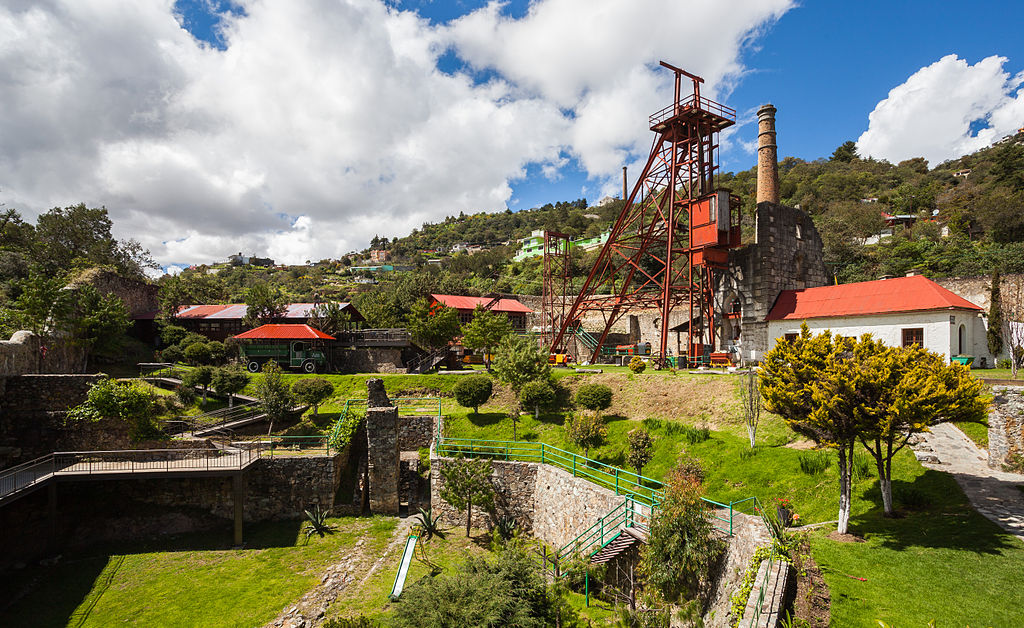
Keep on Digging
Doctor María Teresa Sánchez Salazar has set out very interesting mine “conflict maps” which consider many parameters including land conflict, environmental conflict, social conflict, labor conflict or a combination of those factors. Data shows that 75% of these conflicts have to do with land, that is, land grabs by the mining companies or due to environmental conflicts, and almost 70% of them happen in open-pit mines. Another interesting number – 60% of the conflicts have involved foreign company owned mines.
She adds that there are places where conflict started due to land grab and the subsequent leasing to mining companies and the implementation of ways to displace people from their native lands. Of a total of 181 natural areas, 57 have been leased for mining. Eight of them focus more than 75% of the surface to this activity. Twenty of them have at least 93% of their surface leased. One example is the Rayón National Park in Michoacan, its land is practically 100% leased for mining as well as Huautla Mountain Range that is between Morelos, Puebla and Guerrero.
Safety is also an issue for the Mexican mining sector. There are powerful cartels that have quite an influence in the entire country, including mining states such as Sonora, Chihuahua, Sinaloa and Guerrero. Mines have been object of many armed robberies that have increased during the COVID-19 pandemic. Extortion, threats and employee kidnapping have been the most common crimes reported by the mining companies.
If this was a Robin Hood kind of deal then I should certainly support it, but in the end workers are the most affected, operations are seldom slowed down and the exploitation just does not stop. If the criminal gangs were to take over, not much would change as, let’s be honest, both companies and cartels pretty much operate the same way but at a different scale.
Bacadéhuachi
In times prior to the year 1600, this area was inhabited by Opata indigenous settlements. In the year 1645 a mission named San Luis Gonzága de Bacadéhuachi was founded by the Jesuit missionary Cristóbal García. Its current inhabitants dedicate their lives to taking care of livestock and making cheese, bread and tortillas which are sold among themselves; within the world economy, they don’t have much of a choice. Being only 270 kilometers away from Hermosillo, capital of the State of Sonora, the road takes 5 hours to transit due to the uneven and complex terrain that in turn makes it a dangerous travel.
This town is on the same route of the high mountain range that takes you to Chihuahua, its neighbor state. This is a high-risk road as armed conflicts are constantly raging between groups that are looking to take control of this area. Some months ago, armed men went into the municipality creating such a situation and ending the peaceful environment to the point that the Mexican National Guard and the State Police now have to be constantly present.
Bacadehuachi has around 500 houses, most of them made of adobe, occupied by around 1,083 people according to the The National Institute of Statistics and Geography (INEGI). It has cobblestone roads and few are made of concrete due to the minimal vehicle transit. It is more common to see people on horses or donkeys than in motor vehicles. Everything is around the corner, there are no gas stations nearby. It has 3 municipal police officers that issue around 10 different fines a year. There is only one health center for basic checkups and a doctor is available every 3 days.
Regarding education, only one preschool, one primary school and one secondary school exist. For those who want to receive higher education, their only choice is to go to Granados, a municipality 50 kilometers away from the town. The road is risky to say the least, young students must stay at the neighboring town and go back to their families at the weekends in a municipality sponsored bus. To go to college is a victory, a luxury, a rare occurrence for the townspeople.
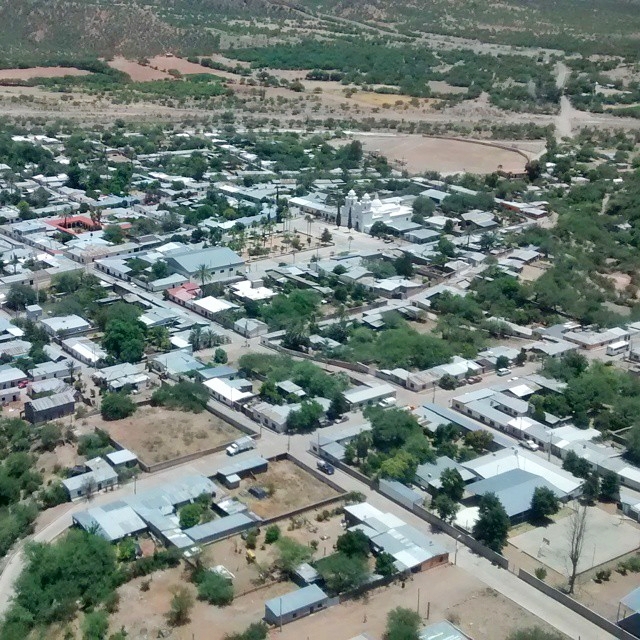
Don’t Know What I’m Selling
Miguel Teran is a farmer and former owner of La Ventana ranch. He sold his land to Bacanora Lithium for the Sonora Lithium Project. He asserts that the first explorations started back in 1994. Geologists came to the La Ventana ranch in government cars. They took some soil samples, came back 8 years later, measured the land and after that they never came back. Ten years ago, Bacanora Lithium carried out some studies. They drilled around 115 holes with the permission of Miguel and then they offered to buy the land.
I told them: you know what you’re buying, but I don’t know what I’m selling. Don’t take advantage of me. That’s how the negotiation started, but they wanted to pay as if it was a mere piece of land.”
Miguel wasn’t disappointed yet he acknowledges that he could have made a better deal as he has since found out what treasure lies in the 1,900 hectares that were sold and integrated into the Sonora Lithium Project. For the time being and until the mineral is extracted, Miguel may allow his cows to graze there as stipulated in the contract.
I am within my rights until I get in the way, but I have already bought some land.” Finally, he adds, “sometimes my car battery would fail and they would tell me that I had lithium here, but I only know about horses and chickens; not lithium.”

The Trauma of Our Technological Selves
As a city-dweller, my experience with Nature has been for the most part parks and decorative gardens. Since I live so disconnected from the land itself, I can only enter into relationship with my own species, our creations and the animals we call pets. For a long time I’ve been scared of insects and even though working in a garden has helped diminish the feeling, I still feel uncomfortable in certain scenarios. Soil and its minerals are even weirder to me, because I had never considered them something other than a resource, a component that can be used for my benefit through technology. They don’t seem alive, they don’t seem to have any other purpose than sitting there for us to transform them into something else.
Perhaps my biggest realization during my journey to connect with the land is the enormous damage that Capitalism, Colonialism and Industrialism have inflicted on the planet. It has reached the point that we are also physically, psychologically, emotionally and spiritually bent and broken enough for us to barely notice the indifference and violence around us. Indifference and violence done to each other and to ourselves. And yet, those who notice don’t always take action. Even less, those who know and take action don’t have a clear idea, much less a strategy to stop the abuse.
This is not something that modern technology can fix. Not the electric cars, not the solar cells nor the electric batteries. Not the tote bags and the bamboo toothbrushes that you can use as compost. Our home is being gutted and we just stand there watching, unsure on what to do. When you actually want to stop a killer, you go ahead and do it. You don’t offer knives from recycled metal or whips made out of hemp. You go ahead and put an end to the abuse by neutralizing any capacity to inflict damage that the perpetrator might have. You stop the killing, you stop the behavior, you commit yourself to do so.
Today I read that only 3% of world’s ecosystems remain intact. Civilization is going down regardless of what we do. Nothing can grow indefinitely without collapsing. The real question is what will be left when our civilization goes down. Our struggle resides in stopping it before there is nothing left.
Cristopher Straffon Marquez a.k.a. Straquez is a theater actor and language teacher currently residing in Tijuana, Baja California, Mexico. Artist by chance and educator by conviction, Straquez was part of the Zeitgeist Movement and Occupy Tijuana Movement growing disappointed by good intentions misled through dubious actions. He then focused on his art and craft as well as briefly participating with The Living Theatre until he stumbled upon Derrick Jensen’s Endgame and consequently with the Deep Green Resistance: Strategy to Save the Planet both changing his mind, heart and soul. Since then, reconnecting with the land, decolonizing the mind and fighting for a living planet have become his goals.
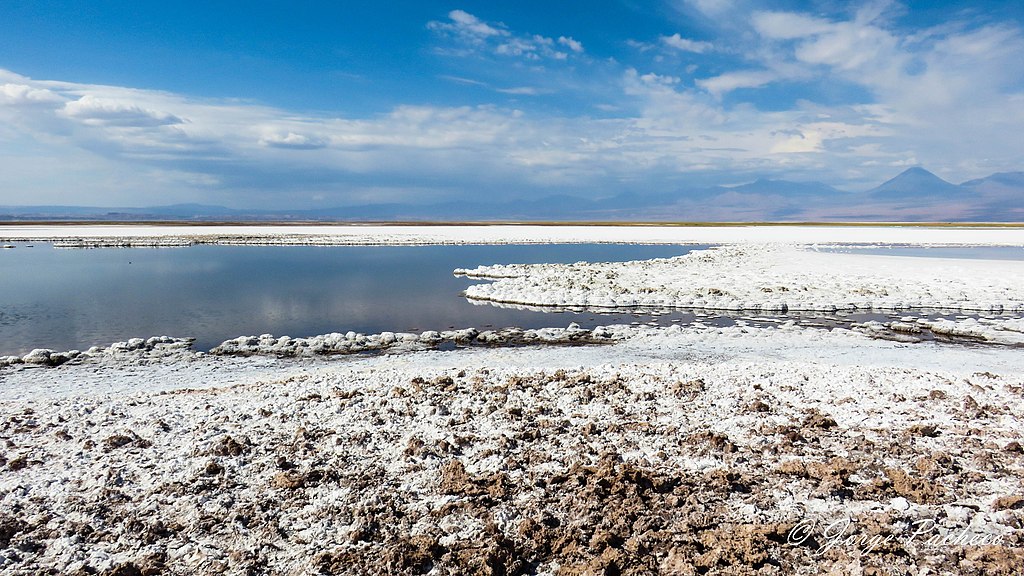
by DGR News Service | May 8, 2021 | Biodiversity & Habitat Destruction, Colonialism & Conquest, Education, Mining & Drilling, Strategy & Analysis, Toxification
By Straquez
Mine is the Ignorance of the Many
I was born in Mexico City surrounded by big buildings, a lot of cars and one of the most contaminated environments in the world. When I was 9 years old my family moved to Tijuana in North West Mexico and from this vantage point, on the wrong side of the most famous border town in the world, I became acquainted with American culture. I grew up under the American way of life, meaning in a third-world city ridden with poverty, corruption, drug trafficking, prostitution, industry and an immense hate for foreigners from the South.
Through my school years, I probably heard a couple of times how minerals are acquired and how mining has brought “prosperity” and “progress” to humanity. I mean, even my family name comes from Cornwall, known for its mining sites. The first Straffon to arrive from England to Mexico did so around 1826 in Real del Monte in the State of Hidalgo (another mining town!). However, it is only recently, since I have started following the wonderful work being done in Thacker Pass by Max Wilbert and Will Falk that the horrors of mining came into focus and perspective.
What is mining? You smash a hole in the ground, go down the hole and smash some more then collect the rocks that have been exposed and process them to make jewelry, medicines or technology. Sounds harmless enough. It’s underground and provides work and stuff we need, right? What ill could come out of it? After doing some digging (excuse the pun), I feel ashamed of my terrible ignorance. Mine is the ignorance of the many. This ignorance is more easily perpetuated in a city where all the vile actions are done just so we can have our precious electronics, vehicles and luxuries.
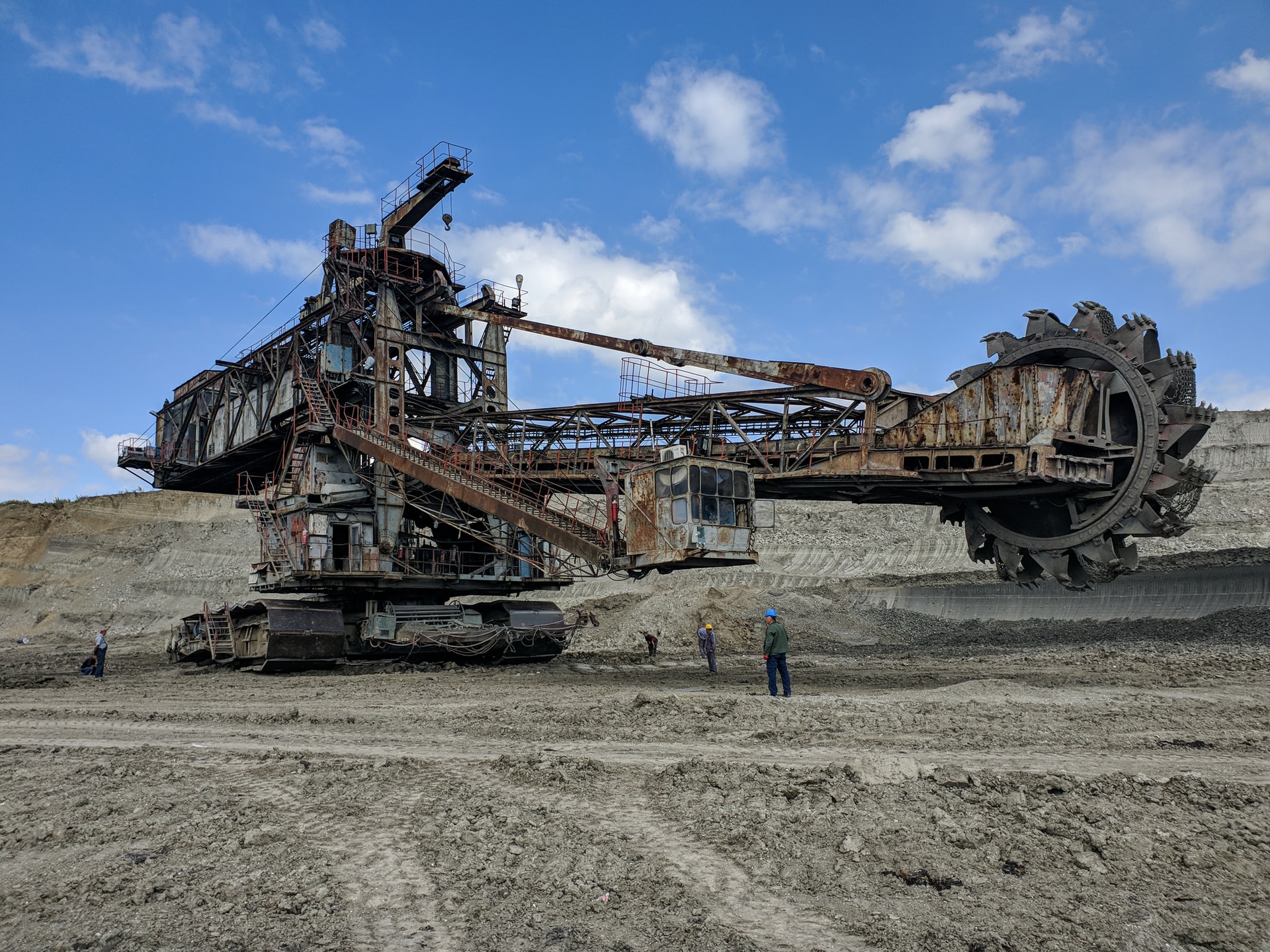
Mine Inc.
Mining, simply put, is the extraction of minerals, metals or other geological materials from earth including the oceans. Mining is required to obtain any material that cannot be grown or artificially created in a laboratory or factory through agricultural processes. These materials are usually found in deposits of ore, lode, vein, seam, reef or placer mining which is usually done in river beds or on beaches with the goal of separating precious metals out of the sand. Ores extracted through mining include metals, coal, oil shale, gemstones, calcareous stone, chalk, rock salt, potash, gravel, and clay. Mining in a wider sense means extraction of any resource such as petroleum, natural gas, or even water.
Mining is one of the most destructive practices done to the environment as well as one of the main causes of deforestation. In order to mine, the land has to be cleared of trees, vegetation and in consequence all living organisms that depend on them to survive are either displaced or killed. Once the ground is completely bare, bulldozers and excavators are used to smash the integrity of the land and soil to extract the metals and minerals.
Mining comes in different forms such as open-pit mining. Like the name suggests, is a type of mining operation that involves the digging of an open pit as a means of gaining access to a desired material. This is a type of surface mining that involves the extraction of minerals and other materials that are conveniently located in close proximity to the surface of the mining site. An open pit mine is typically excavated with a series of benches to reach greater depths.
Open-pit mining initially involves the removal of soil and rock on top of the ore via drilling or blasting, which is put aside for future reclamation purposes after the useful content of the mine has been extracted. The resulting broken up rock materials are removed with front-end loaders and loaded onto dump trucks, which then transport the ore to a milling facility. The landscape itself becomes something out of a gnarly science-fiction movie.
Once extracted, the components are separated by using chemicals like mercury, methyl-mercury and cyanide which of course are toxic to say the least. These chemicals are often discharged into the closest water sources available –streams, rivers, bays and the seas. Of course, this causes severe contamination that in turn affects all the living organisms that inhabit these bodies of water. As much as we like to distinguish ourselves from our wild kin this too affects us tremendously, specially people who depend on the fish as their staple food or as a livelihood.
One of the chemical elements that is so in demand in our current economy is Lithium. Lithium battery production today accounts for about 40% of lithium mining and 25% of cobalt mining. In an all-battery future, global mining would have to expand by more than 200% for copper, by a minimum of 500% for lithium, graphite, and rare earths, and far more for cobalt.
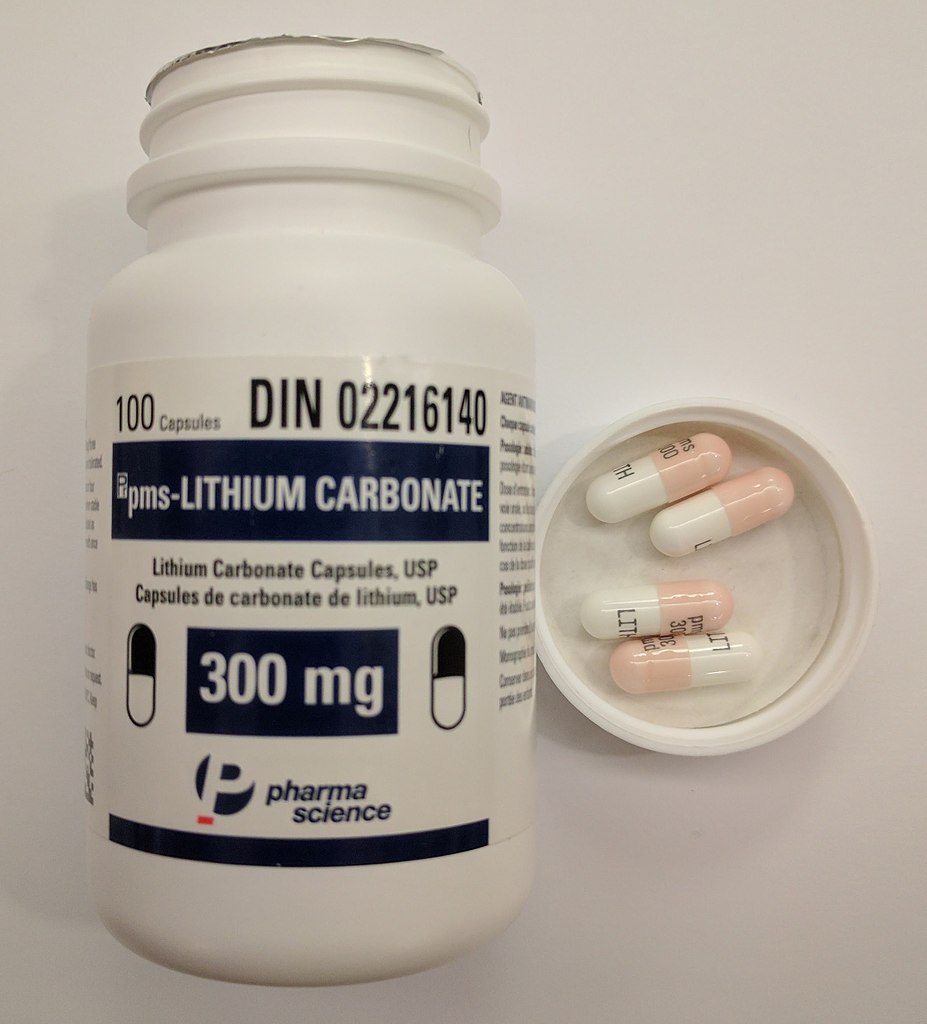
Lithium – Isn’t that a Nirvana song?
Lithium is the lightest metal known and it is used in the manufacture of aircraft, nuclear industry and batteries for computers, cellphones, electric cars, energy storage and even pottery. It also can level your mood in the form of lithium carbonate. It has medical uses and helps in stabilizing excessive mood swings and is thus used as a treatment of bipolar disorder. Between 2014 and 2018, lithium prices skyrocketed 156% . From 6,689 dollars per ton to a historic high of 17,000 dollars in 2018. Although the market has been impacted due to the on-going pandemic, the price of lithium is also rising rapidly with spodumene (lithium ore) at $600 a ton, up 40% on last year’s average price and said by Goldman Sachs to be heading for $676/t next year and then up to $707/t in 2023.
Lithium hydroxide, one of the chemical forms of the metal preferred by battery makers, is trading around $11,250/t, up 13% on last year’s average of $9978/t but said by Goldman Sachs to be heading for $12,274 by the end of the year and then up to $15,000/t in 2023. Lithium is one of the most wanted materials for the electric vehicle industry along cobalt and nickel. Demand will only keep increasing if battery prices can be maintained at a low price.
Simply look at Tesla’s gigafactory in the Nevada desert which produces 13 million individual cells per day. A typical Electronic Vehicle battery cell has perhaps a couple of grams of lithium in it. That’s about one-half teaspoon of sugar. A typical EV can have about 5,000 battery cells. Building from there, a single EV has roughly 10 kilograms—or 22 pounds—of lithium in it. A ton of lithium metal is enough to build about 90 electric cars. When all is said and done, building a million cars requires about 60,000 tons of lithium carbonate equivalent (LCE). Hitting 30% penetration is roughly 30 million cars, works out to about 1.8 million tons of LCE, or 5 times the size of the total lithium mining industry in 2019.
Considering that The United States-Mexico-Canada Agreement (USMCA) is being negotiated, lithium exploitation is a priority as a “must be secured” supply chain resource for the North American corporate machine. In 3 years, cars fabricated in these three countries must have at least 75% of its components produced in the North American region so they can be duty-free. This includes the production of lithium batteries that could also become a profitable business in Mexico.

Sonora on Lithium
In the mythical Sierra Madre Occidental (“Western Mother” Mountain Range) which extends South of the United States, there is a small town known as Bacadéhuachi. This town is approximately 11 km away from one of the biggest lithium deposits in the world known as La Ventana. At the end of 2019, the Mexican Government confirmed the existence of such a deposit and announced that a concession was already granted on a joint venture project between Bacanora Minerals (a Canadian company) and Gangfeng Lithium (a Chinese company) to extract the coveted mineral. The news spread and lots of media outlets and politicians started to refer to lithium as “the oil of the future.”
I quote directly the from Bacanora Lithium website:
Sonora Lithium Ltd (“SLL”) is the operational holding company for the Sonora Lithium Project and owns 100% of the La Ventana concession. The La Ventana concession accounts for 88% of the mined ore feed in the Sonora Feasibility Study which covers the initial 19 years of the project mine life. SLL is owned 77.5% by Bacanora and 22.5% by Ganfeng Lithium Ltd.
Sonora holds one of the world’s largest lithium resources and benefits from being both high grade and scalable. The polylithionite mineralisation is hosted within shallow dipping sequences, outcropping on surface. A Mineral Resource estimate was prepared by SRK Consulting (UK) Limited (‘SRK’) in accordance with NI 43-101.”
The Sonora Lithium Project is being developed as an open-pit strip mine with operation planned in two stages. Stage 1 will last for four years with an annual production capacity of approximately 17,500t of lithium carbonate, while stage 2 will ramp up the production to 35,000 tonnes per annum (tpa). The mining project is also designed to produce up to 28,800 tpa of potassium sulfate (K2SO4), for sale to the fertilizer industry.
On September 1st, 2020, Mexico’s President, Andres Manuel Lopez Obrador, dissolved the Under-secretariat of Mining as part of his administration’s austerity measures. This is a red flag to environmental protection as it creates a judicial void which foreign companies will use to allow them greater freedom to exploit more and safeguard less as part of their mining concession agreements.
Without a sub-secretariat, mediation between companies, communities and environmental regulations is virtually non-existent. Even though exploitation of this particular deposit had been adjudicated a decade ago under Felipe Calderon’s administration, the Mexican state is since then limited to monitoring this project. This lack of regulatory enforcement will catch the attention of investors and politicians who will use the situation to create a brighter, more profitable future for themselves and their stakeholders.
To my mind there is a bigger question – how will Mexico benefit from having one of the biggest deposits of lithium in the world? Taking into account the dissolution of the Mining sub-secretariat and the way business and politics are usually handled in Mexico, I do wonder who will be the real beneficiaries of the aforementioned project.
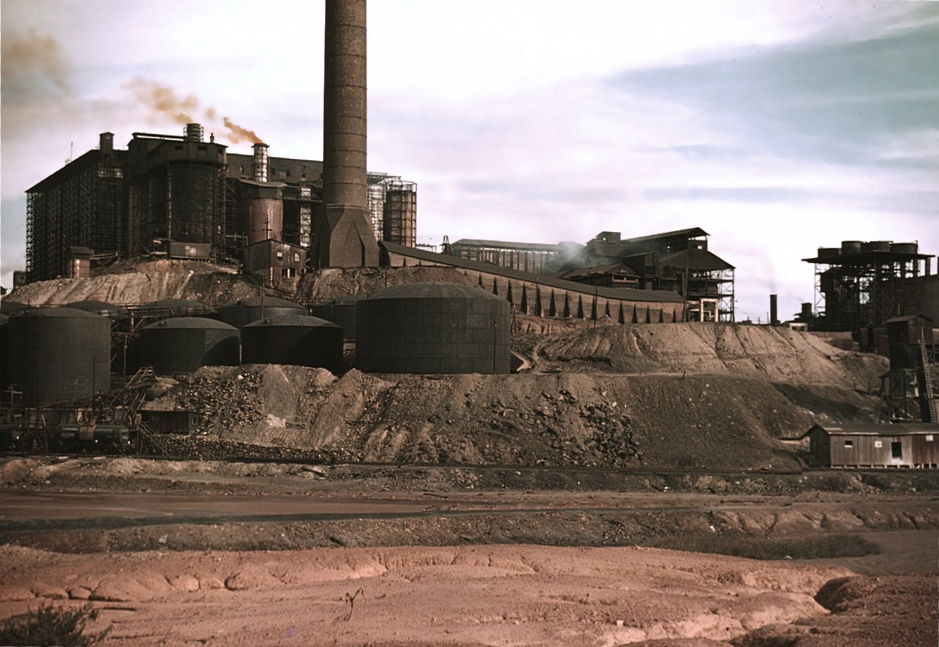
Extra Activism
Do not forget, mining is an integral part of our capitalist economy; mining is a money making business – both in itself and as a supplier of materials to power our industrial civilization. Minerals and metals are very valuable commodities. Not only do the stakeholders of mining companies make money, but governments also make money from revenues.
There was a spillage in the Sonora river in 2014. It affected over 22,000 people as 40 million liters of copper sulfate were poured into its waters by the Grupo Mexico mining group. Why did this happen? Mining companies are run for the profit of its stakeholder and it was more profitable to dump poison into the river than to find a way to dispose it with a lower environmental impact. Happily for the company stakeholders, company profit was not affected in the least.
Even though the federal Health Secretariat in conjunction with Grupo México announced in 2015 the construction of a 279-million-peso (US $15.6-million) medical clinic and environmental monitoring facility to be known as the Epidemiological and Environmental Vigilance Unit (Uveas) to treat and monitor victims of the contamination, until this day it has not been completed. The government turned a blind eye to the incident after claiming they would help. All the living beings near the river are still suffering the consequences.
Mining is mass extraction and this takes us to the practice of “extractivism” which is the destruction of living communities (now called “resources”) to produce stuff to sell on the world market – converting the living into the dead. While it does include mining – extraction of fossil fuels and minerals below the ground, extractivism goes beyond that and includes fracking, deforestation, agro-industry and megadams.
If you look at history, these practices have deeply affected the communities that have been unlucky enough to experience them, especially indigenous communities, to the advantage of the so-called rich. Extractivism is connected to colonialism and neo-colonialism; just look at the list of mining companies that are from other countries – historically companies are from the Global North. Regardless of their origins, it always ends the same, the rich colonizing the land of the poor. Indigenous communities are disproportionately targeted for extractivism as the minerals are conveniently placed under their land.
While companies may seek the state’s permission, even work with them to share the profits, they often do not obtain informed consent from communities before they begin extracting – moreover stealing – their “resources”. The profit made rarely gets to the affected communities whose land, water sources and labor is often being used. As an example of all of this, we have the In Defense of the Mountain Range movement in Coatepec, Veracruz. Communities are often displaced, left with physical, mental and spiritual ill health, and often experience difficulties continuing with traditional livelihoods of farming and fishing due to the destruction or contamination of the environment.
Cristopher Straffon Marquez a.k.a. Straquez is a theater actor and language teacher currently residing in Tijuana, Baja California, Mexico. Artist by chance and educator by conviction, Straquez was part of the Zeitgeist Movement and Occupy Tijuana Movement growing disappointed by good intentions misled through dubious actions. He then focused on his art and craft as well as briefly participating with The Living Theatre until he stumbled upon Derrick Jensen’s Endgame and consequently with the Deep Green Resistance: Strategy to Save the Planet both changing his mind, heart and soul. Since then, reconnecting with the land, decolonizing the mind and fighting for a living planet have become his goals.
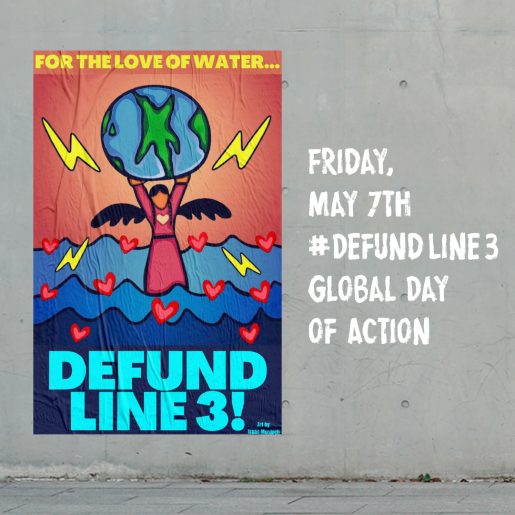
by DGR News Service | May 7, 2021 | Biodiversity & Habitat Destruction, Colonialism & Conquest, Direct Action, Indigenous Autonomy, Mining & Drilling, Movement Building & Support, Noncooperation, Protests & Symbolic Acts, Repression at Home, Toxification, White Supremacy
Original Press Release
Relatives,
Together we are powerful. Since the #DefundLine3 campaign launched in February, bank executives have received more than 700,000 emails, 7,000 calendar invites and 3,000 phone calls, demanding that they stop funding Line 3. There have been protests at bank branches in 16 states. Collectively, we’ve raised more than $70,000 for those on the frontlines.
Now, we’re pulling all of that energy together for one powerful, coordinated day of action.
There are already actions confirmed in more than 40 US cities ― in New York, DC, San Francisco, Chicago, Boston and more ― as well as in the UK, France, Holland, Switzerland, Costa Rica, Canada and Sierra Leone.
If there isn’t an action near you, organize one! Actions can be small. Going to a local bank branch with your friend to deliver a letter or petition can be a powerful action. Actions can be large. Think hundreds of people shutting down the streets outside of a bank’s headquarters.
On the frontlines, more than 240 people have now been arrested for taking bold direct action to stop the construction of Line 3.
Just a few weeks ago, Indigenous Water Protectors sang and prayed inside of a waaginogaaning, the traditional structure of Anishinaabe peoples, as allies locked to each other around the lodge, blocking Line 3 construction for hours.
After they were arrested, the Indigenous Water Protectors were strip-searched, shackled and kenneled ― for nonviolent misdemeanors. Meanwhile, Enbridge has spent hundreds of thousands of dollars on riot gear, tear gas, and weapons for local militarized police forces that are regularly surveilling and harrassing nonviolent Water Protectors.
-Simone Senogles
P.S. Want to learn more about the #DefundLine3 campaign? Check out
this blog or
this blog from Tara Houska, founder of the Giniw Collective.
![Will Thacker Pass, At Last, Be Still? [Dispatches from Thacker Pass]](https://dgrnewsservice.org/wp-content/uploads/sites/18/2021/05/SnowAtThackerPass-980x735-1.jpg)
by DGR News Service | May 5, 2021 | Biodiversity & Habitat Destruction, Indigenous Autonomy, Listening to the Land, Mining & Drilling, Movement Building & Support, Obstruction & Occupation, Repression at Home, Toxification
On a late April morning in Thacker Pass, where some Paiute ancestors have been buried and some massacred, where some people want to dig out the dead to dig out lithium, I woke to a strange, wet snow that fell overnight a day before temperatures in the 70s were forecast. It seemed a bad omen.
By Will Falk
Paiute elders teach that very bad things happen when the dead are disturbed. I knew this must be true. So many industrial projects in so many places have destroyed so many burial sites. The cracked bones of the slain have been cracked again and again in the frantic search for coal. Old, spilled blood turned to soil has been mixed with new, spilled blood by those who murder for oil. Now, in Nevada, if the lithium miners have their way, those brave Paiute who died resisting American soldiers will finally be forced onto the reservation when machinery agitates the dust formed by those Paiute bodies and the wind blows that dust to coat the homes of Paiute descendants at Fort McDermitt.
Either these desecrations have caused the world to go to hell or the dead, disturbed, have brought hell to Earth.
I pondered this while pondering the surreality of the spring snow. As heavy as it was, the snow didn’t weigh the ghosts down. Fingers that once clawed with shock at bullet holes, clawed through mud made by their own blood. The ghosts climbed through the sage brush roots and volcanic rocks, to drift over the snow and confront the living with the reality of history. Moans moved with heavy clouds. Screams, sometimes, did too. Raven wings stirred the death hanging on the air. The wind blew with their last words in a language I never knew.
Though the language was strange to me, the meaning was clear enough: each generation’s missing and murdered grieve for the next. A meadowlark, landed on the tip of a nearby sagebrush, and began to sing. He sang: “While there’s still time for some, there’s no time for grief.” He told me to let them grieve.
I threw some cedar on the fire and watched my prayers rise with the smoke. I wondered what the wind will do when there are no more dying words to deliver, what the dead will do when they are confident they will not be disturbed, what the ghosts will do when their lessons are remembered. I wondered: Will Thacker Pass, at last, be still?
You can find out more and support Thacker Pass:
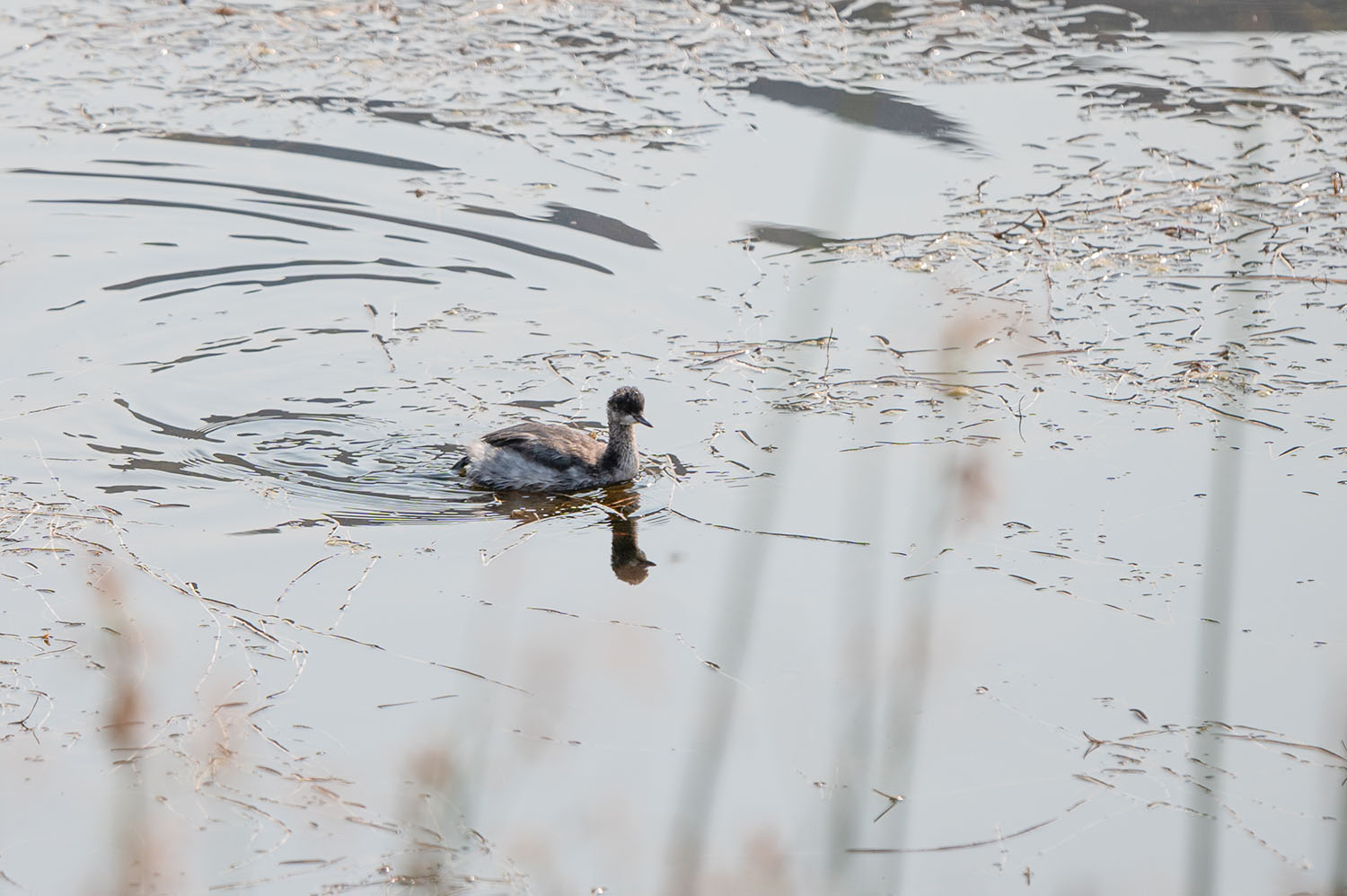
by DGR News Service | May 4, 2021 | Biodiversity & Habitat Destruction, Climate Change, Listening to the Land, Mining & Drilling, Movement Building & Support, Toxification
In this article Rebecca Wildbear talks about how civilization is wasting our planet’s scarce water sources for mining in its desperate effort to continue this devastating way of life.
By Rebecca Wildbear
Nearly a third of the world lacks safe drinking water, though I have rarely been without. In a red rock canyon in Utah, backpacking on a week-long wilderness training in my mid-twenties, it was challenging to find water. Eight of us often scouted for hours. Some days all we could find to drink was muddy water. We collected rain water and were grateful when we found a spring.
Now water is scarce, and the demand for it is growing. Globally, water use has risen at more than twice the rate of population growth and is still increasing. Ninety percent of water used by humans is used by industry and agriculture, and when groundwater is overused, lakes, streams and rivers dry up, destroying ecosystems and species, harming human health, and impacting food security. Life on Earth will not survive without water.
In the Navajo Nation in Arizona, Utah, and New Mexico, a third of houses lack running water, and in some towns, it is ninety percent. Peabody Energy Corporation, the largest coal producer and a Fortune 500 company, pulled so much water from the Navajo aquifer before closing its mining operation that many wells and springs have run dry. Residents now have to drive 17 miles to wait in line for an hour at a communal well, just to get their drinking water.
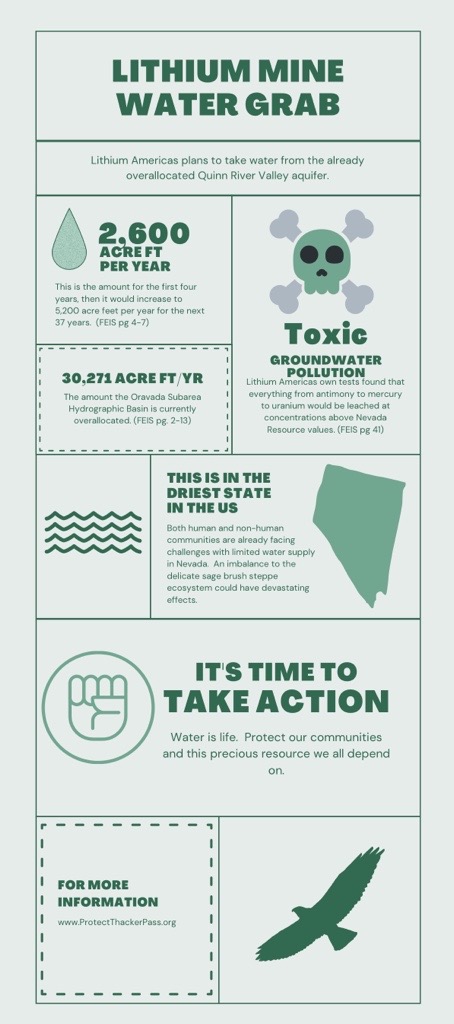
Worldwide, the majority of drinkable water comes from underground reservoirs called aquifers. Aquifers feed streams, lakes, and rivers, but their waters are finite. Large aquifers exist beneath deserts, but these were created eons ago in wetter times. Expert hydrologists say that like oil, once the “fossil” waters of ancient reservoirs are mined, they are gone forever.
Peabody’s Black Mesa Mine extracted, pulverized, and mixed coal with water drawn from the Navajo aquifer to form a slurry. This was sent along a 273-mile-long pipeline to the Mojave Generating Station in Laughlin, Nevada, to power Los Angeles. Every year, the mine extracted 1.4 billion gallons (4,000+ acre feet) of water from the aquifer, an estimated 45 billion gallons (130,000+ acre feet) in all.
Pumping out an aquifer draws down the water level and empties it forever. Water quality deteriorates and springs and soil dry out. Agricultural irrigation and oil and coal extraction are the biggest users of waters from aquifers in the U.S. Some predict that the Ogallala aquifer, once stretching beneath five mid-western states, may be able to replenish after six thousand years of rainfall.
Rain is the most accurate measure of available water in a region, yet over-pumping water beyond its capacity to refill is widespread in the western U.S. and around the world. The Middle East ran out of water years ago—it was the first major region in the world to do so. Studies predict that two thirds of the world’s population are at risk of water shortages by 2025. As ground water levels fall, lakes, rivers, and streams are depleted, and the land, fish, trees, and animals die, leaving a barren desert.
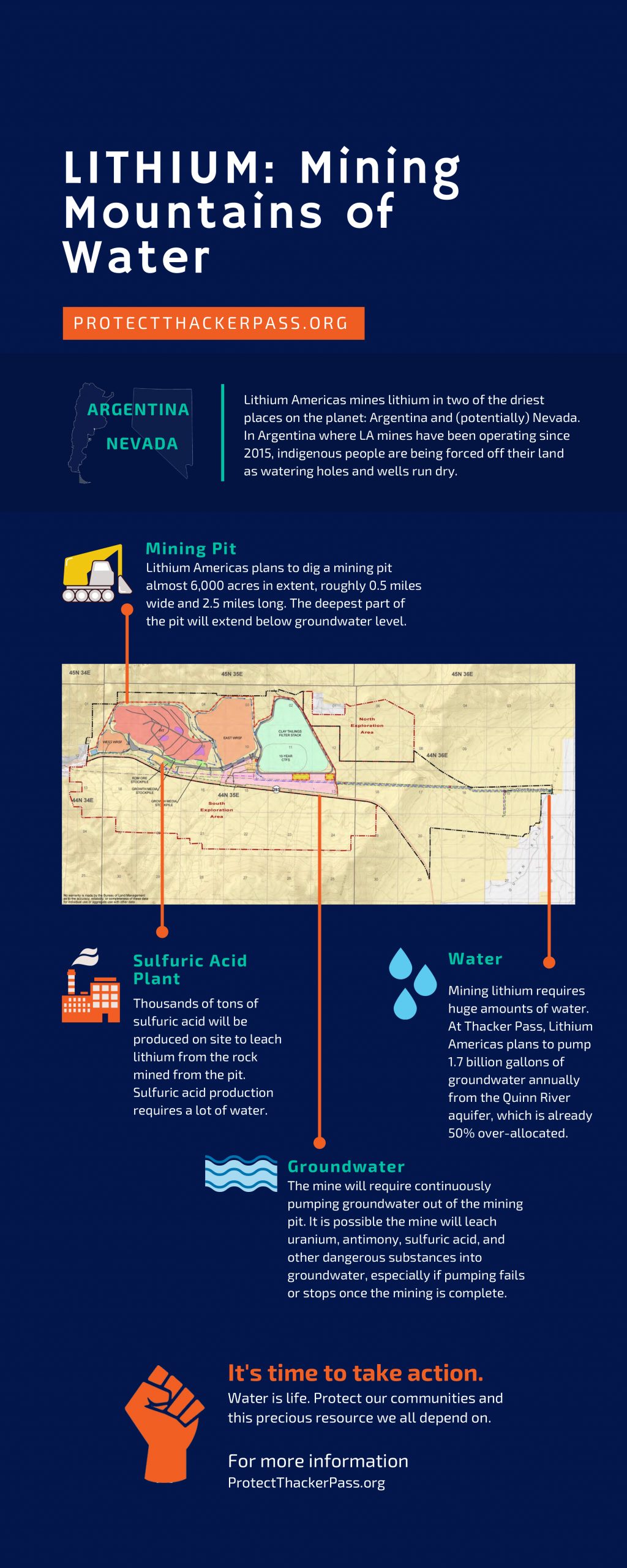
Mining in the Great Basin
The skyrocketing demand for lithium, one of the minerals needed for the production of electric cars, is based on the misperception that green technology helps the planet. Yet, as Argentine professor of thermodynamics and lithium mining expert Dr. Daniel Galli said at a scientific meeting, lithium mining is “really mining mountains of water.” Lithium Americas plans to pump massive amounts of water—up to 1.7 billion gallons (5,200 acre feet) annually—from an aquifer in the Quinn River Valley in Nevada’s Great Basin, the largest desert in the United States.
Thacker Pass, the site of the proposed 1.3 billion dollar open-pit lithium mine, would pump 1,200 acre feet more water per year than Peabody Energy Corporation extracted from the Navajo aquifer. Yet, the Quinn River aquifer is already over-allocated by fifty percent, and more than 10 billion gallons (30,000 acre feet) per year. Nevada is one of the driest states in the nation, and Thacker Pass is only the first of many proposed lithium mines in the state. Multiple active placer claims (7,996) have been located in 18 different hydrographic basins.
Deceit about water fuels these mines. Lithium Americas’ environmental impact assessment is grossly inaccurate, according to hydrologist Dr. Erick Powell. By classifying year-round creeks as “ephemeral” and underreporting the flow rate of 14 springs, Lithium Americas is claiming there is less water in the area than there actually is. This masks the real effects the mine would have—drying up hundreds of square miles of land, drawing down the groundwater level, sucking water from neighboring aquifers—all while claiming its operations would have no effect.
Peabody Energy Corporation’s impact assessment similarly misrepresented how their withdrawals would harm the Navajo aquifer. Peabody Energy used a flawed method to measure the withdrawals, according to former National Science Research Fellow Daniel Higgins. Now Navajo Nation wells require drilling down 2,000–3,000 feet, and the water is depressurized and slow to flow to the surface.
Thacker Pass lithium mine would pump groundwater at a disturbing rate, up to 3,250 gallons per minute. Once used, wastewater would contaminate local groundwater with dangerous heavy metals, including a “plume” of antimony that would last at least 300 years. Lithium Americas plans to dig the mine deeper than the groundwater level and keep it dry by continuously pumping water out, but when the pumping stops, groundwater would seep back in, picking up the toxins.
It hurts me to think about this. I imagine water being rapidly extracted from my own body, my bloodstream poisoned. The best tasting water rises to the surface when it is ready, after gestating as long as it likes in the dark Earth. Springs are sacred. When I feel welcome, I place my lips on the earthy surface and fill my mouth with their sweet flavor and vibrant texture.
Mining in the Atacama Desert
Thirteen thousand feet above sea level, the indigenous Atacamas people live in the Atacama Desert, the most arid desert in the world and the driest place on Earth. For millennia, they have used their scarce supply of water and sparse terrain carefully. Their laws and spirituality have always been intertwined with the health and well-being of the land and water. Living in mud-brick homes, pack animals, llama and alpaca, provide them with meat, hide, and wool.
But lithium lies beneath their ancestral land. Since 1980, mining companies have made billions in the Salar de Atacama region in Chile, where lithium mining now consumes sixty-five percent of the water. Some local communities need to have water driven in, and other villagers have been forced to abandon their settlements. There is no longer enough water to graze their animals. Beautiful lagoons hundreds of flamingos call home have gone dry. The birds have disappeared, and the ground is hard and cracked.
In addition to the Thacker Pass mine proposal, Lithium Americas has a mine in the Atacama Desert, a joint Canadian-Chilean venture named Minera Exar in the Cauchari-Olaroz basin in Jujuy, Argentina. Digging for lithium began in Jujuy in 2015, and there is already irreversible damage, according to a 2018 hydrology report. Watering holes have gone dry, and indigenous leaders are scared that soon there will be nothing left.
Even more water is needed to mine the traces of lithium found in brine than in an open-pit mine. At the Sales de Jujuy plant, the wells pump at a rate of more than two million gallons per day, even though this region receives less than four inches of rain a year. Pumping water from brine aquifers decreases the amount of fresh groundwater. Freshwater refills the spaces emptied by brine pumping and is irreversibly mixed with brine and salinized.
The Sanctity of Water
As a river guide, I live close to water. Swallowed by its wild beauty, I am restored to a healthier existence. Far from roads, cars, and cities, I watch water swirl around rocks or ripple over sand. I merge with its generous flow, floating through mountains, forest, or canyon. Rivers teach me how to listen to the currents—whether they cascade in a playful bubble, swell in a loud rush, or ebb in a gentle silence—for clues about what lies ahead.
The indigenous Atacamas peoples understand that water is sacred and have purposefully protected it for centuries. Rather than looking at how nature can be used, our culture needs to emulate the Atacamas peoples and develop the capacity to consider its obligations around water. Instead of electric cars, what we need is an ethical approach to our relationship with the land. Honoring the rights of water, species, and ecosystems is the foundation of a sustainable society. Decisions can be made based on knowledge of the land, weather patterns, and messages from nature.
For millennia, indigenous peoples have perceived water, animals, and mountains as sentient. If humans today could recognize their intelligence, perhaps they would understand that underground reservoirs have a value and purpose, beyond humans. When I enter a cave, I am walking into a living being. My eyes adjust to the dark. Pressing my hand against the wall, I steady myself on the uneven ground, hidden by varying amounts of water. Pausing, I listen to a soft dripping noise, echoing like a heartbeat as dew slides off the rocks. I can almost hear the cave breathing.
The life-giving waters of aquifers keep everything alive, but live unseen under the ground. As a soul guide, I invite people to be nourished by the visions of their dreams, a parallel world that is also seemingly invisible. Our dominant culture dismisses the value of these perceptions, just as it usurps water by disregarding natural cycles. Yet to create a sustainable world, humans need to be able to listen to nature and their dreams. The depths of our souls are inextricably linked to the ancient waters that flow underground. Dreams arise like springs from an aquifer, seeding our visionary potential, expanding our consciousness, and revealing other ways to live, radically different than empire.
Water Bearers
I set my backpack down on a high sandstone cliff overlooking a large watering hole. Ten feet below the hole, the red rock canyon drops into a much larger pool. My friend hikes down to it, filling her cookpot with water. She balances it atop her head on the way up, moving her hips to keep the pot steady. Arriving back, she pours the water into the smaller hole from which we drink and returns to the large pool to gather more.
Women in all societies have carried water throughout history. In many rural communities, they still spend much of the day gathering it. Sherri Mitchell of the Penobscot Nation calls women “the water bearers of the Universe.” The cycles in a woman’s body move in relation with the Earth’s tides, guiding them to nourish and protect the waters of Earth. We all need to become water bearers now.
Indigenous peoples, who have always been the Earth’s greatest defenders, protect eighty percent of global diversity, even though they comprise less than five percent of the world’s population. They understand water is sacred, and the world’s groundwater systems must be defended. For six years, indigenous peoples have been fighting to prevent lithium mining in the Salinas Grandes salt flats, in Jujuy, Argentina. Five hundred indigenous people camped on the land with signs: “No to lithium. Yes, to water and life in our territories.”
In February 2021, President Biden signed executive orders supporting the domestic mining of “critical” minerals like lithium, but two lawsuits, one by five Nevada-based conservation groups, have been filed against the Bureau of Land Management for approving the Thacker Pass lithium mine. Environmentalists Max Wilbert and Will Falk are organizing a protest to protect Thacker Pass. Local residents, including Northern Paiute and Western Shoshone peoples, are speaking out, fighting to protect their land and water.
We can see when a river runs dry, but most people are not aware of the invisible, slow-burning disaster happening under the ground. Some say those who oppose lithium mining should give up cell phones. If that is true, perhaps those who favor mines should give up drinking water. Protecting water needs to be at the center of any plan for a sustainable future.
The “fossil water” found in deserts should be used only in emergency, certainly not for mining. Sickened by corporate water grabbing, I support those trying to stop Thacker Pass Lithium mine and aim to join them. The aquifers there have nurtured so many for so long—eagles, pronghorn antelope, mule deer, old-growth sagebrush, hawks, falcons, sage-grouse, and Lahontan cutthroat trout. I pray these sacred wombs of the Earth can live on to nourish all of life.
For more on the issue:













![Will Thacker Pass, At Last, Be Still? [Dispatches from Thacker Pass]](https://dgrnewsservice.org/wp-content/uploads/sites/18/2021/05/SnowAtThackerPass-980x735-1.jpg)


